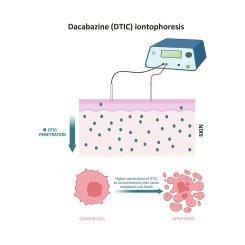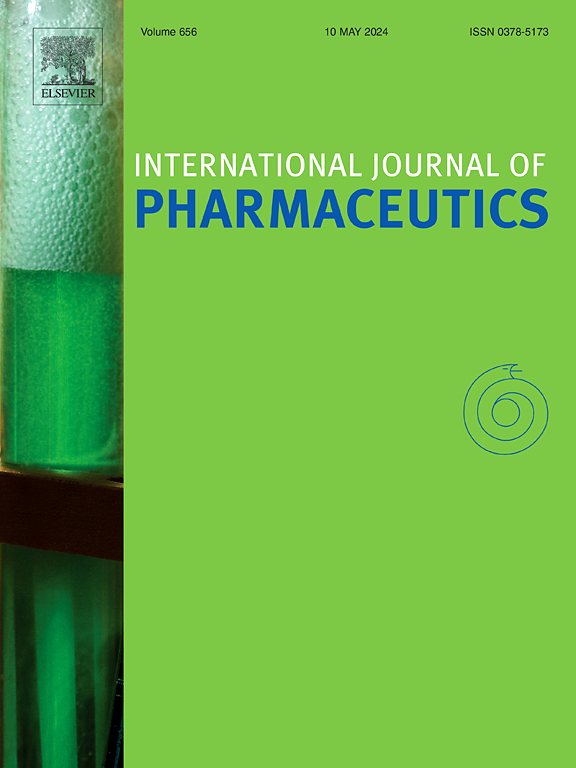Effect of iontophoresis on dacarbazine cutaneous delivery for melanoma topical treatment
IF 5.3
2区 医学
Q1 PHARMACOLOGY & PHARMACY
引用次数: 0
Abstract
Dacarbazine (DTIC) is the drug of choice for melanoma treatment, but its systemic administration is related to several adverse effects. Here, DTIC topical delivery stimulated by iontophoresis is proposed to overcome such drawbacks. Hence, this work analyzed the impact of anodal iontophoresis on DTIC cutaneous delivery to provide an innovative topical alternative for melanoma treatment. The electrical stability of the drug was evaluated prior to the iontophoretic experiments, which demonstrated the need to add an antioxidant to the drug formulation. DTIC cutaneous permeation was evaluated in vitro for 6 h using three current densities (0.10, 0.25, and 0.50 mA/cm2). In addition, the effect of DTIC against skin cancer cells (MeWo and WM164) was investigated for 72 h of exposure to the drug. Iontophoresis stimulated skin drug permeation compared to the passive control. However, the antioxidant presence reduced DTIC permeation under the lower currents of 0.10 and 0.25 mA/cm2, which was compensated by increasing the current density to 0.50 mA/cm2. At 0.50 mA/cm2, iontophoresis enhanced topical cutaneous drug permeation 7-fold (p < 0.05) compared to the passive control. DTIC showed a concentration-dependent antiproliferative effect on melanoma cell lines. Thus, iontophoresis intensifies DTIC skin penetration in concentrations that can reduce cell viability and induce cell death. In conclusion, DTIC cutaneous delivery mediated by iontophoresis is a promising approach for treating melanomas and other skin tumors.

电离子渗透对黑色素瘤局部治疗中达卡巴嗪皮肤给药的影响
达卡巴嗪(DTIC)是治疗黑色素瘤的首选药物,但全身用药会产生一些不良反应。为了克服这些弊端,有人提出了利用离子透入技术刺激 DTIC 局部给药的方法。因此,本研究分析了阳极离子透入对 DTIC 皮肤给药的影响,从而为黑色素瘤治疗提供一种创新的局部给药替代方法。在进行离子渗透实验之前,对药物的电稳定性进行了评估,结果表明有必要在药物配方中添加抗氧化剂。在体外使用三种电流密度(0.10、0.25 和 0.50 mA/cm2)对 DTIC 的皮肤渗透性进行了 6 小时的评估。此外,还研究了 DTIC 与皮肤癌细胞(MeWo 和 WM164)接触 72 小时后的效果。与被动对照组相比,离子透入疗法刺激了皮肤的药物渗透。然而,在 0.10 和 0.25 mA/cm2 的较低电流下,抗氧化剂的存在会降低 DTIC 的渗透,而将电流密度提高到 0.50 mA/cm2 则可弥补这一不足。在 0.50 毫安/平方厘米的电流密度下,电离子渗透将局部皮肤药物渗透提高了 7 倍(p
本文章由计算机程序翻译,如有差异,请以英文原文为准。
求助全文
约1分钟内获得全文
求助全文
来源期刊
CiteScore
10.70
自引率
8.60%
发文量
951
审稿时长
72 days
期刊介绍:
The International Journal of Pharmaceutics is the third most cited journal in the "Pharmacy & Pharmacology" category out of 366 journals, being the true home for pharmaceutical scientists concerned with the physical, chemical and biological properties of devices and delivery systems for drugs, vaccines and biologicals, including their design, manufacture and evaluation. This includes evaluation of the properties of drugs, excipients such as surfactants and polymers and novel materials. The journal has special sections on pharmaceutical nanotechnology and personalized medicines, and publishes research papers, reviews, commentaries and letters to the editor as well as special issues.

 求助内容:
求助内容: 应助结果提醒方式:
应助结果提醒方式:


